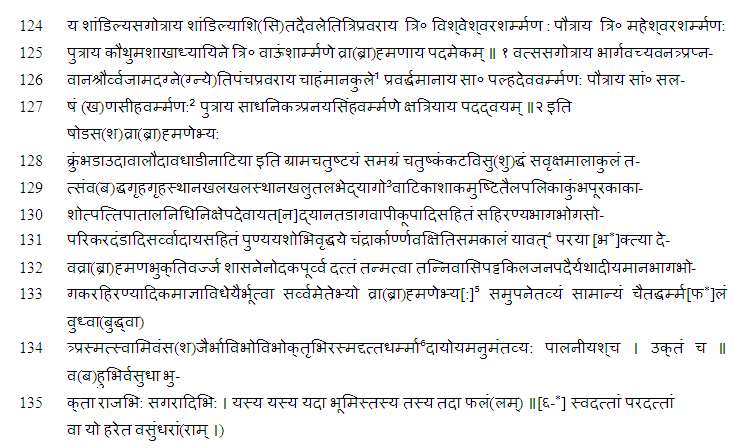| |
North
Indian Inscriptions |
| |
|
|
|
INSCRIPTIONS OF THE PARAMARAS OF MALWA

Fourth Plate : Second Side
 _________________________________________________________
[1] This is the local pronunciation of the word.
[2] The Sanskrit form of this name is Sallakshaṇasiṁha. The preceding sā here stands for sādhanika. Sircar draws attention to its Prākrit equivalent Sāhaṇia, meaning the ‘commander of an army, and
adds that the P. C. M. uses the expression mah¬ās¬ādhanika in the sense of a chieftain or military
governor (See Sircar, op. cit., p. 142). But the word can more easily be connected with s¬ādhana in the sense of “an army” (See Mudrārākshasa, V, 10). This shows that the he was a military officer.
[3] The word khalu is so placed here as to appear a noun but it is not found in the lexicons. Tala-bhēdya is also a queer word and Sircar doubted whether it means ‘pits’.
[4] Unlike other consonants appearing in this inscription, this consonant is marked halanta and not
joined to the following letter.
[5] The sign of visarga is omitted here and the original shows a very faint dot in its place, subsequently
inserted.
[6] As often noted above, this word (with mā) is more current in Mālwā even to this day. The reason is
not known to me. Possibly, it means धर्मस्य त्र्प्रादाय==त्र्प्रादानम्; i, e., achieving dharma by making
donations.
[7] The visarga is erroneously dropped here in consideration of the following vowel.
[8] The medial ā-sign, which was originally omitted here, was inserted subsequently in a short form and
so as its lowest extremity just touching the top-stroke.
[9] The first of the daṇḍas, though placed near the preceding akshara, is quite separate from it and is
also endowed with a top-stroke.
|
\D7
![]()
|









